Intake length testing and results
#1
Intake length testing
Intro
I’ve been fortunate the last month to get my car on the dyno and play around with some stuff. One of the things I have been meaning to improve is a dip in torque around 4200-5000RPM… right where I need all the torques to get out of the corners. It’s noticeable against the faster cars in class. I know some of them have at least 15whp on me at peak, and generally more power everywhere.
We know that resonance from the intake can have an impact on the engines torque delivery, so I a few hours on the dyno adjusting the intake length between the throttle and air filter. I haven’t seen this discussed too much in the mx5/miata community, so figure I would post the process and results.
Brief summary of the car/engine
I live in Brisbane, Australia and the car is built to Motorsport Australia’s (formerly know as CAMS) 2f production sports rule set. To put this into some perspective think supermiata, with semi slick tyres and internal engine mods, but no aero. Unfortunately, 2f is a diminishing class, with Queensland having one of the largest grids (~10 cars per event), whilst in the other states 2f is pretty much non-existent now. 10 years ago and there were grids of 25 to 30 mx5s... It’s a multi car class, so we’ve had a few 86s join in recent years, but the grid is generally mx5s of all generations. We also have multiple classes on the track at the same time (this helps with numbers, else we wouldn’t get any track time), with class 2b having everything from turbo mx5s to 997 gt3 cup cars…
The Car it's not turbo...
The Engine
Now, some of you might be thinking “why so little power – you can get 150 hp from a standard vvt engine and some bolt ons… I think this has to do with corrections etc. Or maybe we have less horses in Australia? Either way, we’re going to be looking at the change in numbers/trend.
The two images I took of the actual car that day…
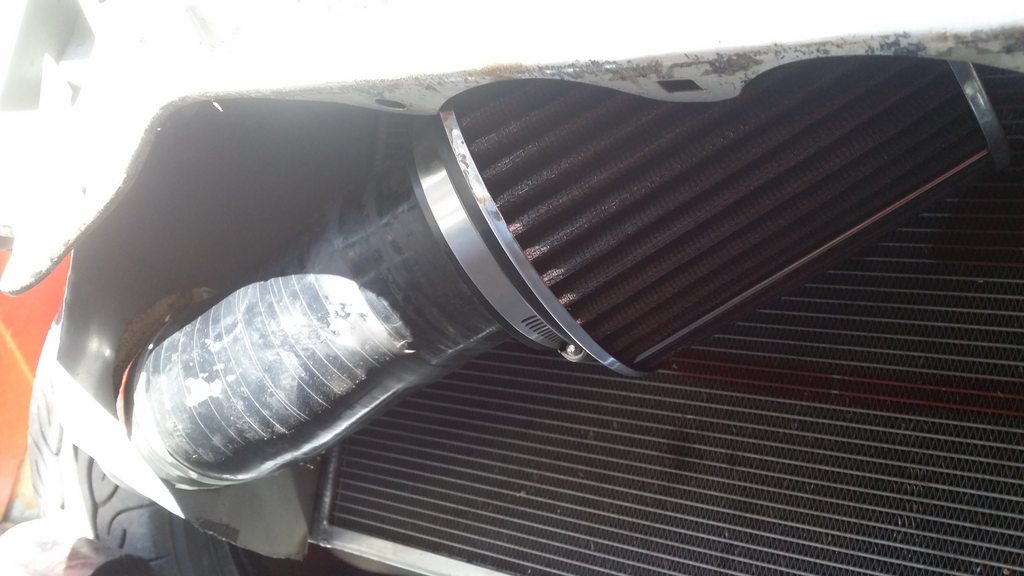
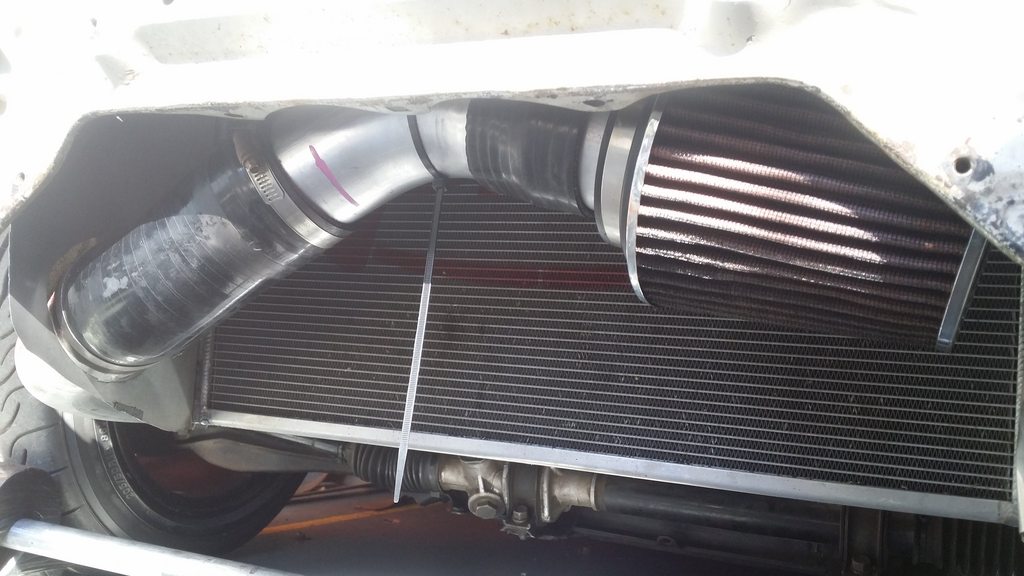
Aim
Find the intake length for the best torque from 4000RPM… that fits.
Hypothesis
I can gain some mid-range torque/power at WOT by varying the intake length.
Method
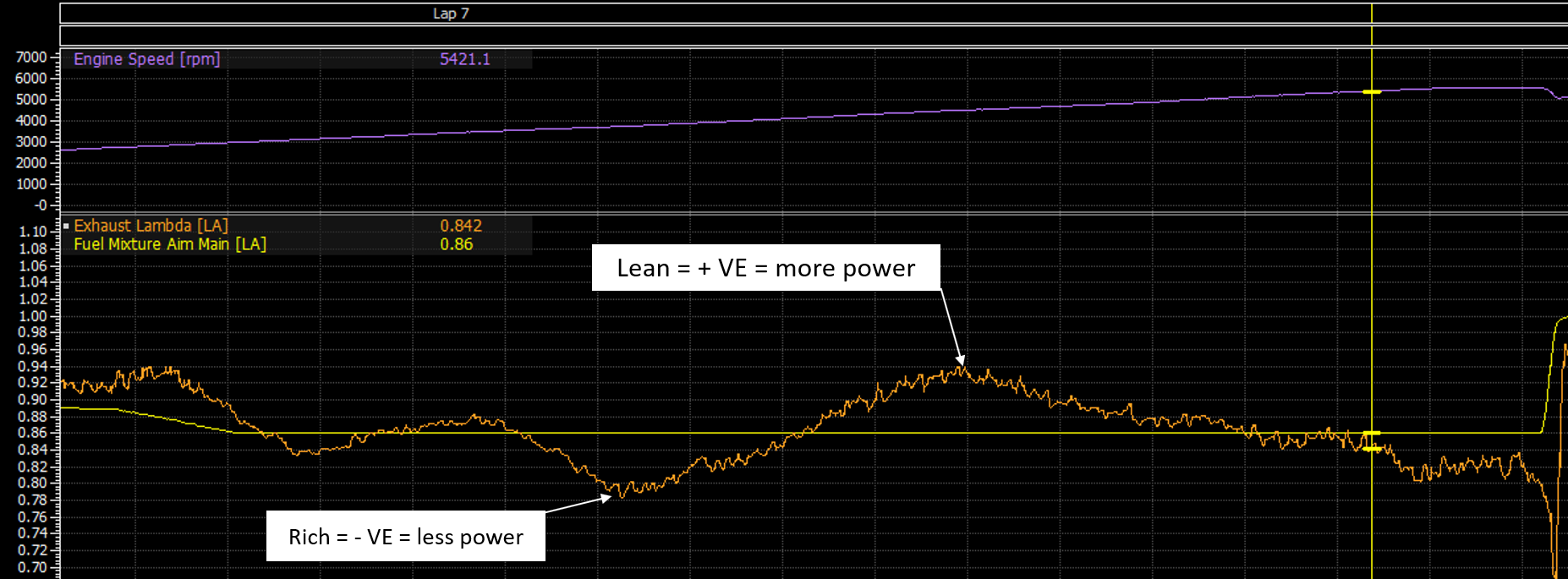
Results/waffle
The below image shows a lambda trendline for each run. I’ve added a key to the image showing the variation in length from the base line. The variations were quick ballpark measurements, so could easily be ± 20-40mm. Where the lambda trend is leaner (more air) than the red baseline run, the engine efficiency has increase, and if richer (less air) it has decreased.
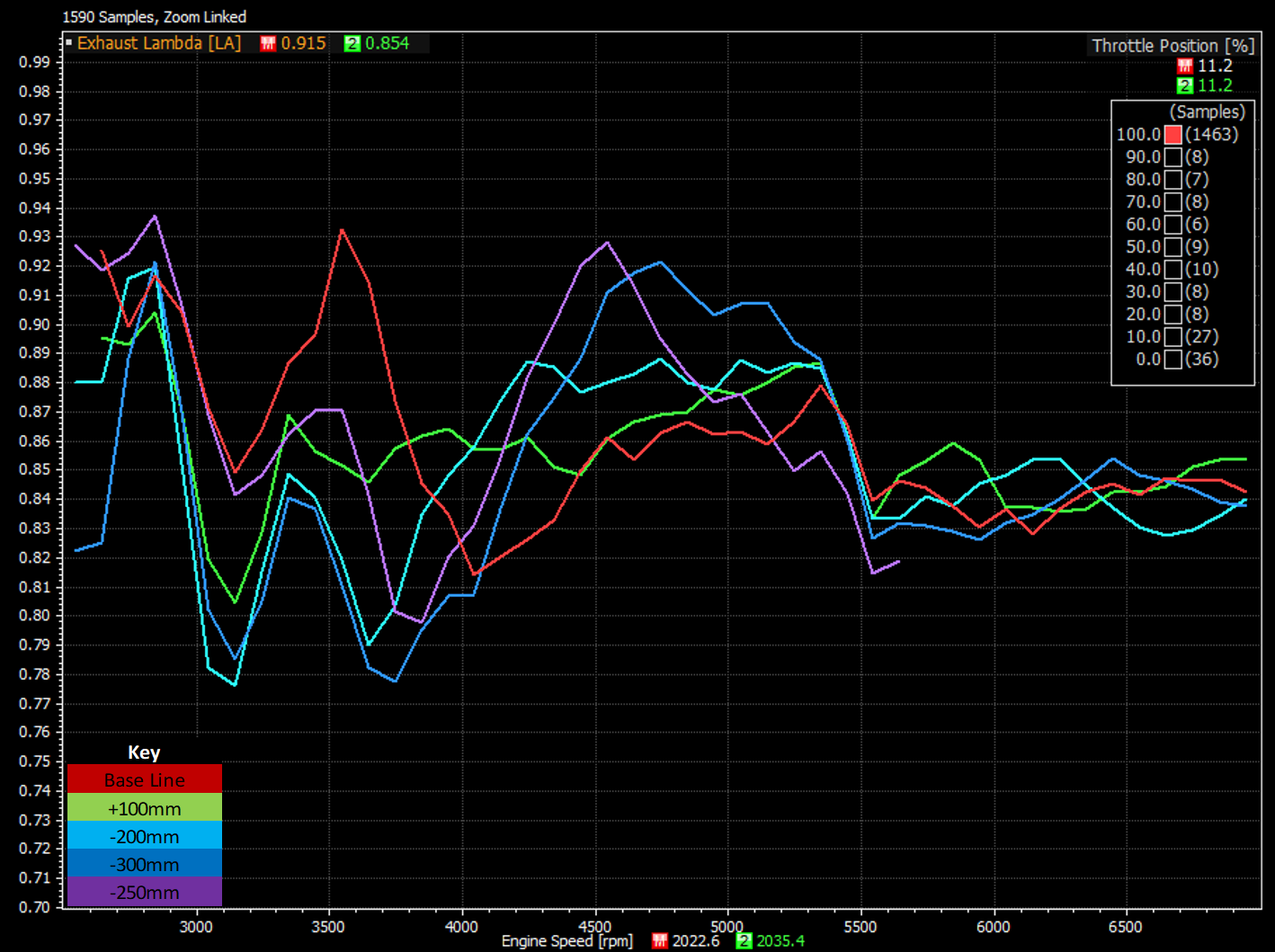
The following image shows compares baseline, -300mm and -250mm. -300 did give me more from 4600 to 5500RPM, but didn’t really work with the bumper and cooling ducting on, and I was hoping to get the power gains from 4000RPM. I would say the -250 run is closer to -200 than -250, however it fit and still gave the car a good improvement, even though the improvements had tapered off by 5000RPM. I should have grabbed the dyno data for the -300mm run to have really compared them.
I guess this is where the exhaust and/or cam timing would have to be altered to see if you could get some more above 5000, and keep the gains down low. I will try play with cam timing again at some point in the future.
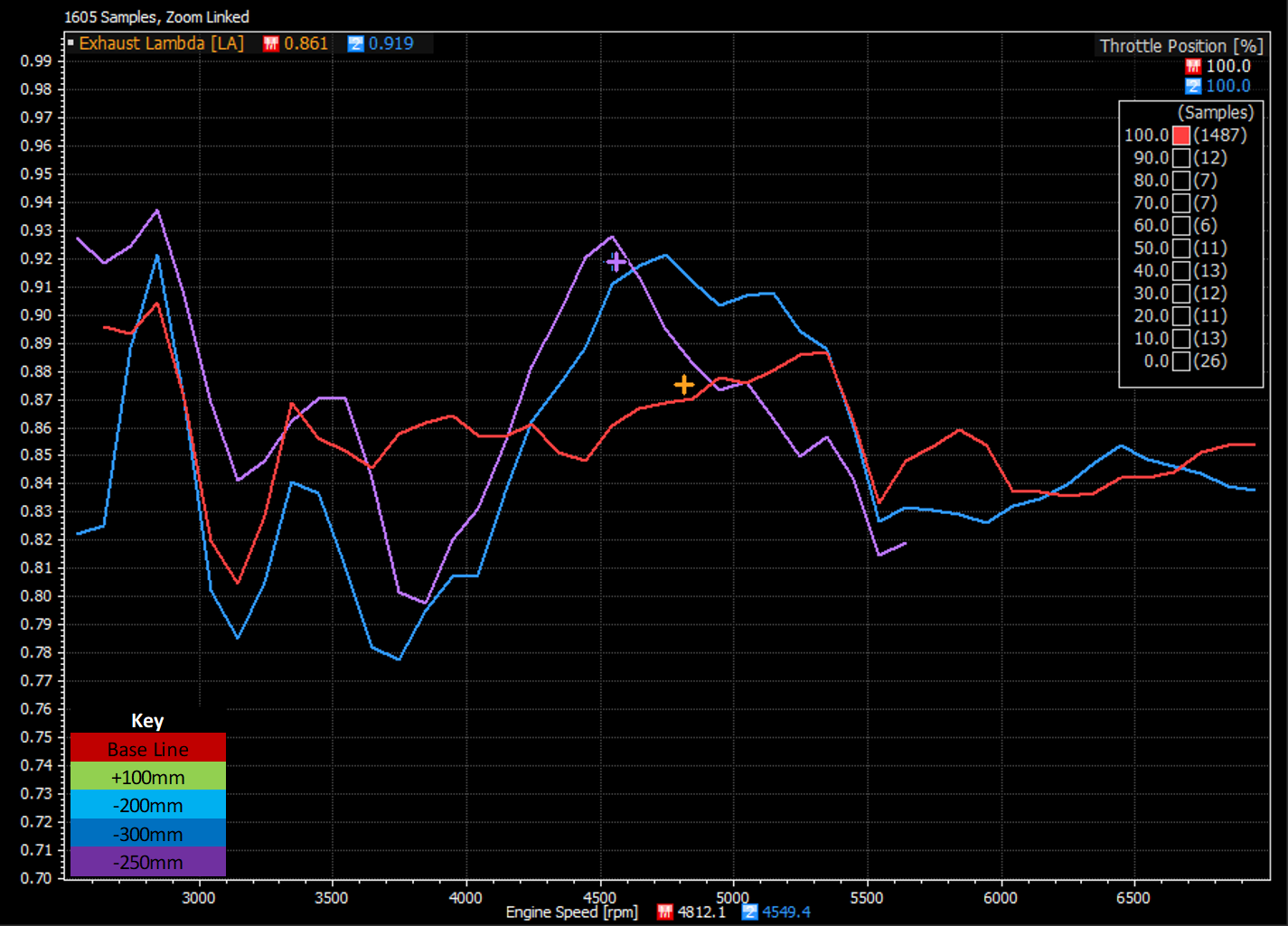
Finally, the results…
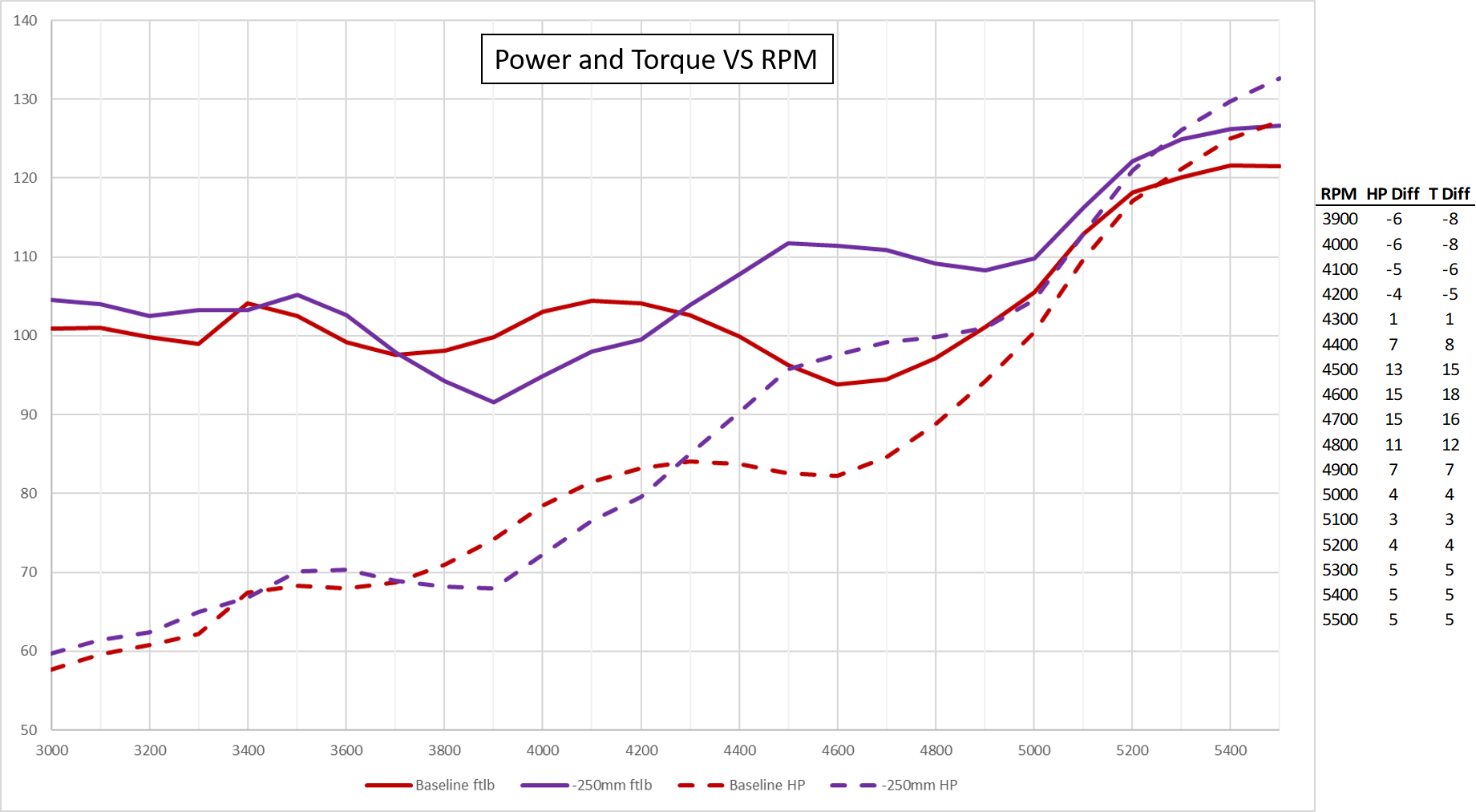
Once we had locked in the length, I was only doing runs upto 5500 to dial in the fuel map. Compared to baseline, there was a loss in torque up to 4300, by 4600, the engine has gained 18 ftlb (19%). The gains taper off, but it still holds slightly more torque through to 5500 RPM – I’m not sure if these small gains are reliable, but generally the dyno results get worse as everything gets hotter throughout the day. There were some minor losses above 5500 and we didn’t actually do another full run to 7k, so I need to fix up the fuel map after some track testing. The final WOT run with the engine efficiency map sorted is shown below, compared to baseline.
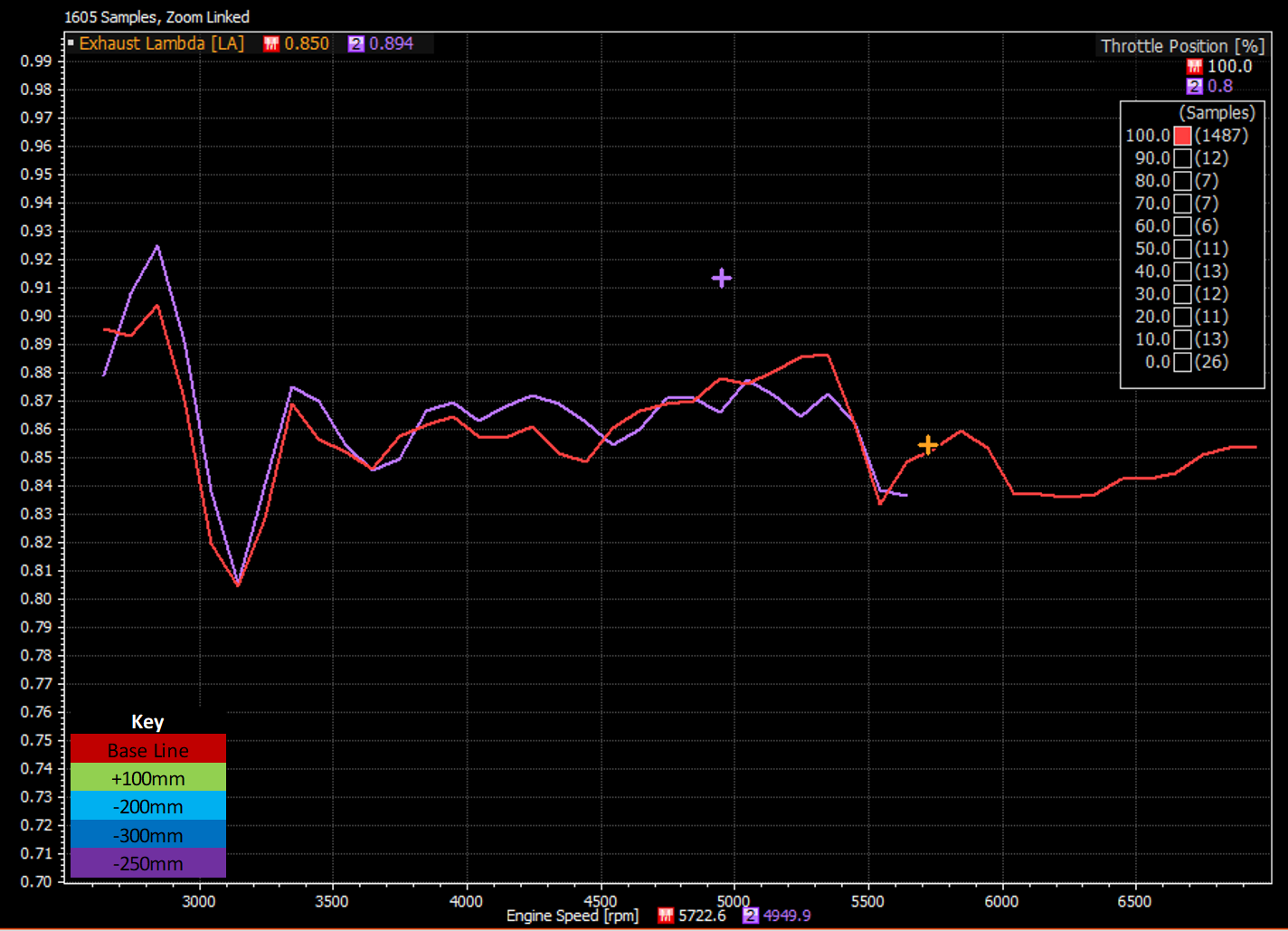
Track testing
After a late night putting the bumper back on and packing the car, I was out at Lakeside for some testing. I could not notice this difference in power, but I did notice I was more consistently hitting a stage on the shift lights that I don’t always hit coming out of hungry (a left hander and up a hill). I even noticed this on the warmup lap.
I had driven the car out so was using yokohamma AD08R street tyres and I have only previous used them at this track once, in February. Comparing the intake air temps, February was 31*C and the first test in June was 21*C, so a much cooler day. Previous PB was 61.1 on natsoft (timing beacon) and 60.98 from the motec. I was able to throw down some faster and very consistent laps, even whilst trying to get used to non-vacuum assisted brakes.
I have looked at the data a bit and haven’t come up with a very good strategy for quantifying the improvements seen on the dyno, but the lap times speak for themselves.
I was able to put down a 60.5s and string together multiple 60.6-60.9s laps (sectors below), and as far as I am concerned, my braking was sloppy. Not only was I very inconsistent in terms of brake pressure, I had used cheap fluid and did not have any cooling hooked up, so they would get a bit spongy after a few hot laps. Was pretty happy with the result, and I know my braking can be improved once I get used to extra pedal force required.
For reference, I raced at Lakeside in March, 30*C intake air temp, nice day, obviously track is more rubbered in racing conditions and my best time and new pb was 59.5 on Yokohamma A050s. I was consistently in the low 60s, and did a few consecutive 59s.
I returned to Lakeside 2 weeks later to get some more testing in. Same tyres, 22*C Intake air temps, same time of day = similar track conditions. I didn’t have as much clean track time, but able to get down to a 60.36 and do a few laps under my previous pb of 60.5. Still with average braking.
I very keen to head out to lakeside again soon whilst the weather is still cool with the A050s and see what I can do.

Right click on the image and click view in new tab (or similar) to enlarge it
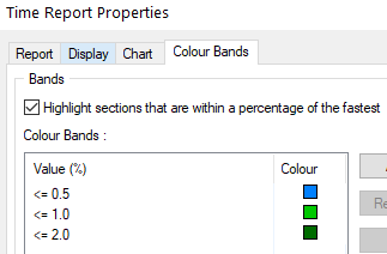
The images above show the lap times and sector splits for the two test sessions. The i2 sector time sheet is pretty handy, I can quickly glance at it after a race and see how consistent I was by comparing the Eclectic time (sum of best sectors) vs my best lap time for that session – If there’s only a few 10ths in it, I am usually pretty happy, as this means I was fairly consistent. Another handy feature is the cell shading based of a percentage of the best sector. The purple sectors are the fastest (obviously) and blue, and shaded cells are within a percentage of the fastest sector, and set as show in last image. If I find my best time was 0.5s slower or something than the theoretical best, then I know I either had a really tough race or wasn’t very consistent, and might go looking for better explanations/excuses in the data.
You can see during the second test I wasn’t as consistent but did set some faster sectors. We can see that I had a good lap 14 and it gave me a great sector 1 for lap 15, but then I slowed down for the next two sectors.
Thanks for reading if you made it this far. Any feedback/questions greatly appreciated. I hope to do another post regarding braking, boosted vs non boosted.
Intro
I’ve been fortunate the last month to get my car on the dyno and play around with some stuff. One of the things I have been meaning to improve is a dip in torque around 4200-5000RPM… right where I need all the torques to get out of the corners. It’s noticeable against the faster cars in class. I know some of them have at least 15whp on me at peak, and generally more power everywhere.
We know that resonance from the intake can have an impact on the engines torque delivery, so I a few hours on the dyno adjusting the intake length between the throttle and air filter. I haven’t seen this discussed too much in the mx5/miata community, so figure I would post the process and results.
Brief summary of the car/engine
I live in Brisbane, Australia and the car is built to Motorsport Australia’s (formerly know as CAMS) 2f production sports rule set. To put this into some perspective think supermiata, with semi slick tyres and internal engine mods, but no aero. Unfortunately, 2f is a diminishing class, with Queensland having one of the largest grids (~10 cars per event), whilst in the other states 2f is pretty much non-existent now. 10 years ago and there were grids of 25 to 30 mx5s... It’s a multi car class, so we’ve had a few 86s join in recent years, but the grid is generally mx5s of all generations. We also have multiple classes on the track at the same time (this helps with numbers, else we wouldn’t get any track time), with class 2b having everything from turbo mx5s to 997 gt3 cup cars…
The Car it's not turbo...
- 1993 Eunos roadster (mazda mx5 or miata) - straight from japan... via NZ.
- Ohlins DFV shocks (jap spec apparently there’s a different to EU and US spec), 11.6kg/mm front springs, 6kg/mm rears
- sway bars - standard or 949 14mm rear bar depending on track
- Wheels - 6ul 15x8, wrapped in yokohamma A050s (mediums)
- V8 roadster dynapro BBK front brakes, na8 rear brakes on Flyin Miata brackets with NB8B discs.
The Engine
- Mazda BP05
- Extensively ported head… not as extensive as some though.
- Camshafts – started life as toda’s but have been modified. 250* at 50 thou duration, 10mm lift
- Inlet: 4mm lift at TDC (around 98* lobe centre)
- Exhaust: 3.4mm lift at TDC (around 102* lobe centre)
- SR20 Valves, +1mm on standard.
- SR20 beehive springs
- 11:1 compression (measured assembled)
- Custom CP pistons
- Maxpeeding conrods (ebay)
- Standard BP05 intake manifold and throttle body
- Custom/local 4-2-1 headers, mid pipe and racing beat muffler.
- cold air intake
Now, some of you might be thinking “why so little power – you can get 150 hp from a standard vvt engine and some bolt ons… I think this has to do with corrections etc. Or maybe we have less horses in Australia? Either way, we’re going to be looking at the change in numbers/trend.
The two images I took of the actual car that day…


Aim
Find the intake length for the best torque from 4000RPM… that fits.
Hypothesis
I can gain some mid-range torque/power at WOT by varying the intake length.
Method
- Put car on dyno, less front bumper (really need to remember to take more photos)
- Turn off O2 ctrl etc
- Tune base line (map need a few adjustments after the e85 tests)
- Adjust intake length
- WOT ramp run, 3 – 7k RPM
- Compare lambda of modified intake length to aim. It is pretty easy to see an increase in engine efficiency using the lambda – even easier on the M1 where I can pause the data after the run. Example in the picture below.
- Repeat
- Once determined the best length, see if I can make it work with the bumper/ducting
- Set intake length
- Fix fuel map

Results/waffle
The below image shows a lambda trendline for each run. I’ve added a key to the image showing the variation in length from the base line. The variations were quick ballpark measurements, so could easily be ± 20-40mm. Where the lambda trend is leaner (more air) than the red baseline run, the engine efficiency has increase, and if richer (less air) it has decreased.

The following image shows compares baseline, -300mm and -250mm. -300 did give me more from 4600 to 5500RPM, but didn’t really work with the bumper and cooling ducting on, and I was hoping to get the power gains from 4000RPM. I would say the -250 run is closer to -200 than -250, however it fit and still gave the car a good improvement, even though the improvements had tapered off by 5000RPM. I should have grabbed the dyno data for the -300mm run to have really compared them.
I guess this is where the exhaust and/or cam timing would have to be altered to see if you could get some more above 5000, and keep the gains down low. I will try play with cam timing again at some point in the future.

Finally, the results…

Once we had locked in the length, I was only doing runs upto 5500 to dial in the fuel map. Compared to baseline, there was a loss in torque up to 4300, by 4600, the engine has gained 18 ftlb (19%). The gains taper off, but it still holds slightly more torque through to 5500 RPM – I’m not sure if these small gains are reliable, but generally the dyno results get worse as everything gets hotter throughout the day. There were some minor losses above 5500 and we didn’t actually do another full run to 7k, so I need to fix up the fuel map after some track testing. The final WOT run with the engine efficiency map sorted is shown below, compared to baseline.

Track testing
After a late night putting the bumper back on and packing the car, I was out at Lakeside for some testing. I could not notice this difference in power, but I did notice I was more consistently hitting a stage on the shift lights that I don’t always hit coming out of hungry (a left hander and up a hill). I even noticed this on the warmup lap.
I had driven the car out so was using yokohamma AD08R street tyres and I have only previous used them at this track once, in February. Comparing the intake air temps, February was 31*C and the first test in June was 21*C, so a much cooler day. Previous PB was 61.1 on natsoft (timing beacon) and 60.98 from the motec. I was able to throw down some faster and very consistent laps, even whilst trying to get used to non-vacuum assisted brakes.
I have looked at the data a bit and haven’t come up with a very good strategy for quantifying the improvements seen on the dyno, but the lap times speak for themselves.
I was able to put down a 60.5s and string together multiple 60.6-60.9s laps (sectors below), and as far as I am concerned, my braking was sloppy. Not only was I very inconsistent in terms of brake pressure, I had used cheap fluid and did not have any cooling hooked up, so they would get a bit spongy after a few hot laps. Was pretty happy with the result, and I know my braking can be improved once I get used to extra pedal force required.
For reference, I raced at Lakeside in March, 30*C intake air temp, nice day, obviously track is more rubbered in racing conditions and my best time and new pb was 59.5 on Yokohamma A050s. I was consistently in the low 60s, and did a few consecutive 59s.
I returned to Lakeside 2 weeks later to get some more testing in. Same tyres, 22*C Intake air temps, same time of day = similar track conditions. I didn’t have as much clean track time, but able to get down to a 60.36 and do a few laps under my previous pb of 60.5. Still with average braking.
I very keen to head out to lakeside again soon whilst the weather is still cool with the A050s and see what I can do.

Right click on the image and click view in new tab (or similar) to enlarge it

The images above show the lap times and sector splits for the two test sessions. The i2 sector time sheet is pretty handy, I can quickly glance at it after a race and see how consistent I was by comparing the Eclectic time (sum of best sectors) vs my best lap time for that session – If there’s only a few 10ths in it, I am usually pretty happy, as this means I was fairly consistent. Another handy feature is the cell shading based of a percentage of the best sector. The purple sectors are the fastest (obviously) and blue, and shaded cells are within a percentage of the fastest sector, and set as show in last image. If I find my best time was 0.5s slower or something than the theoretical best, then I know I either had a really tough race or wasn’t very consistent, and might go looking for better explanations/excuses in the data.
You can see during the second test I wasn’t as consistent but did set some faster sectors. We can see that I had a good lap 14 and it gave me a great sector 1 for lap 15, but then I slowed down for the next two sectors.
Thanks for reading if you made it this far. Any feedback/questions greatly appreciated. I hope to do another post regarding braking, boosted vs non boosted.
#4
Good post!
When I installed the Stewart engine in my (nominally, at least to start) 2F car, Gary gave me a number for inlet length. That is now lost in the mists of time, but my filter ended up in a similar position, but on the other side, having crossed the engine bay from the TB, gone down the far side, and turned back to end up in front of the radiator. Long!
I also placed a deflector in front of the filter, mainly to keep the rain and crap off the element. Being low and exposed has its downsides ...
When I installed the Stewart engine in my (nominally, at least to start) 2F car, Gary gave me a number for inlet length. That is now lost in the mists of time, but my filter ended up in a similar position, but on the other side, having crossed the engine bay from the TB, gone down the far side, and turned back to end up in front of the radiator. Long!
I also placed a deflector in front of the filter, mainly to keep the rain and crap off the element. Being low and exposed has its downsides ...
#5
Yeah, gary recommends 1100mm for 2f cars but has found testing on the dyno can help get the power where you want it. He also runs different cams, usually higher lift and less duration than I have... and his heads flow better. Mines pretty good at 5mm lift, but starts to plateau at 10mm, his don't start to drop off until about 11-12mm. He's running standard valves too.
#6
You know we have done this testing already?
BP wants about 21" ~530mm +/- 15mm
B6 wants about 19"
This was not guesswork but a few hundred dyno runs under controlled conditions. Article here: https://supermiata.com/diy-miata-intake.aspx
Filter in front of radiator gets cold air but also gets water logged in the rain and gets dirty faster. You can get intake temps down to ambient with careful filter placement in engine bay.
BP wants about 21" ~530mm +/- 15mm
B6 wants about 19"
This was not guesswork but a few hundred dyno runs under controlled conditions. Article here: https://supermiata.com/diy-miata-intake.aspx
Filter in front of radiator gets cold air but also gets water logged in the rain and gets dirty faster. You can get intake temps down to ambient with careful filter placement in engine bay.
__________________
#7
I think I read that a few years ago and forgot all about it... Was it on miata.net? Didn't try super hard, but couldn't get the IAT with a filter in the bay anywhere near ambient, it was easy +20*C on ambient. What have you had to do to get the IATs down with the filter in the bay. It the class, I can't have any ducting and have to keep the headlights etc. The intent is that is looks as close to the production car as possible. It's an odd rule set, and very old.
Interestingly, your recommend length is about half the length that the main BP engine builder here in Brisbane recommends. It should be easy enough to test again when I have some spare time, so i'll give it a go and see if we get any improvement.
I know shifting the cam timing around can influence the harmonics, any details on the engine you tested it on, or is the timing something you have played around with?
I know from testing done here that the short intakes have never yield good results for mid range with a 2f spec, or modified engine.
Interestingly, your recommend length is about half the length that the main BP engine builder here in Brisbane recommends. It should be easy enough to test again when I have some spare time, so i'll give it a go and see if we get any improvement.
I know shifting the cam timing around can influence the harmonics, any details on the engine you tested it on, or is the timing something you have played around with?
I know from testing done here that the short intakes have never yield good results for mid range with a 2f spec, or modified engine.
#8
Assuming you are keeping the filter in the location that we recommend, iat's are not a problem in our testing. It is important to not only dyno test but to test on the road. We did a lot of both to confirm our "lab results" on the dyno were repeatable. Of the many configurations we tested were pipes that were a foot or so longer then our current recipe. Doing multiple dyno pulls we were able to get an average and after looking at a chart we saw a simple bell curve. If you run the intake pipe behind the radiator, you will absorb its heat and that is very difficult to manage. Has Stewart engine published any dyno data or is their recommendation based solely on calculations? Our recipe has been used on the full range of builds from completely stock ~125whp to heavily modified with big cams ~190whp. Finding a good place for the filter and fitting the pipe on the cold side can be a challenge with the 21 in length but it pays dividends.
__________________
#9
Yeah, I've got plenty of data from road driving, track and the dyno over the years, with a few different engine configs. Stock vvt, standard BP05, BP05 with mild cams, and now the race engine. Basically, IAT were never close to the ambient when the intake was in the engine bay. IATs generally measured within 100-200mm of the TB. With my current config, I wouldn't be able to get an air filter anywhere down the cold side of the car, but will get some 2.5" pipe and see what I can come up with.
You won't find much info about the Stewart engines unless the owners have posted it up. He's been in his current workshop for over 30 years, and has been playing with engines for a lot longer than that. Everything from 2 stroke race bikes, rebuilding old F1 engines, and has been developing B6 and BP engines since they landed in Aus. Unfortunately he's retired now and it's going to have a big impact on the local mx5 race community - there aren't a lot of shops willing to play with mx5 engines over here, or people willing to pay the $100+/hr (AUD) for the work to be done. I assume the financials are the reason you guys stopped selling built engines as well?
Not to mention the rule sets don't lend themselves to keeping the engines stock. It would be great to get something like spec or super miata over here, but we really don't have the willing participants/numbers.
As for testing, he has written on one of the whiteboards - "I don't have an opinion, I have a flow bench and a dyno." which pretty much sums it up. He has done/does a lot of math in the background, but everything is developed and confirmed on his engine and the chassis dyno.
You won't find much info about the Stewart engines unless the owners have posted it up. He's been in his current workshop for over 30 years, and has been playing with engines for a lot longer than that. Everything from 2 stroke race bikes, rebuilding old F1 engines, and has been developing B6 and BP engines since they landed in Aus. Unfortunately he's retired now and it's going to have a big impact on the local mx5 race community - there aren't a lot of shops willing to play with mx5 engines over here, or people willing to pay the $100+/hr (AUD) for the work to be done. I assume the financials are the reason you guys stopped selling built engines as well?
Not to mention the rule sets don't lend themselves to keeping the engines stock. It would be great to get something like spec or super miata over here, but we really don't have the willing participants/numbers.
As for testing, he has written on one of the whiteboards - "I don't have an opinion, I have a flow bench and a dyno." which pretty much sums it up. He has done/does a lot of math in the background, but everything is developed and confirmed on his engine and the chassis dyno.
#10
Boost Pope


iTrader: (8)
Join Date: Sep 2005
Location: Chicago. (The less-murder part.)
Posts: 33,048
Total Cats: 6,607
Now, some of you might be thinking “why so little power – you can get 150 hp from a standard vvt engine and some bolt ons… I think this has to do with corrections etc. Or maybe we have less horses in Australia? Either way, we’re going to be looking at the change in numbers/trend.
Interesting data and methods.
#12
You know we have done this testing already?
BP wants about 21" ~530mm +/- 15mm
B6 wants about 19"
This was not guesswork but a few hundred dyno runs under controlled conditions. Article here: https://supermiata.com/diy-miata-intake.aspx
Filter in front of radiator gets cold air but also gets water logged in the rain and gets dirty faster. You can get intake temps down to ambient with careful filter placement in engine bay.
BP wants about 21" ~530mm +/- 15mm
B6 wants about 19"
This was not guesswork but a few hundred dyno runs under controlled conditions. Article here: https://supermiata.com/diy-miata-intake.aspx
Filter in front of radiator gets cold air but also gets water logged in the rain and gets dirty faster. You can get intake temps down to ambient with careful filter placement in engine bay.
#15
@plohl you may recall Slammer? he got his filter down near where you have yours.....got water in it....Not sure if he got Hydrolic lock.....but it wasn't pretty.
we have the ability to go through the fire wall for some wonderful opera theatrics with the Loch Steward intake which also reduces temps since our steering wheel is on the opposite side to North America. Agreed reduction of temps are probably better where you have it now. but with this you don't have the danger of flooding your engine with water.
on another note ....you have some serious cam duration there . quite different to mine. I would lover to see where the torque goes once it hits 6500-7500 rpm
my engine sounds very similar to yours.
cams are slightly less aggressive but It seems you have significant amount more torque @4000 RPM did you say yours is a VVT?
perhaps that could be because I have slightly more compression 11.5:1?
some minor porting,
square top
Modified OEM headers with 2.25 exsaust
standard valves
VVT bottom end
BP-4W head. milled to withing an inch of its life.
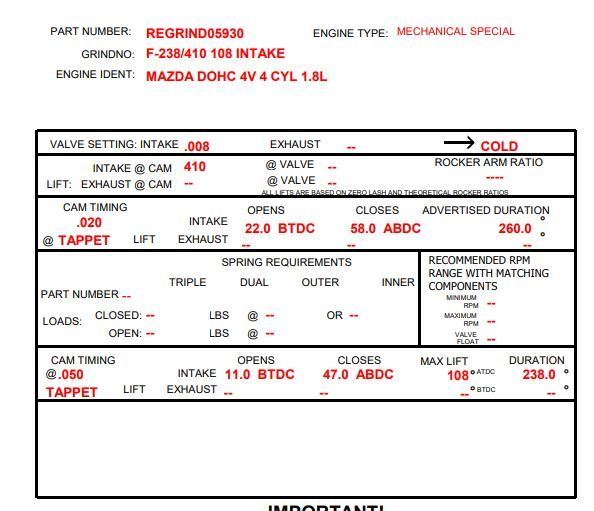
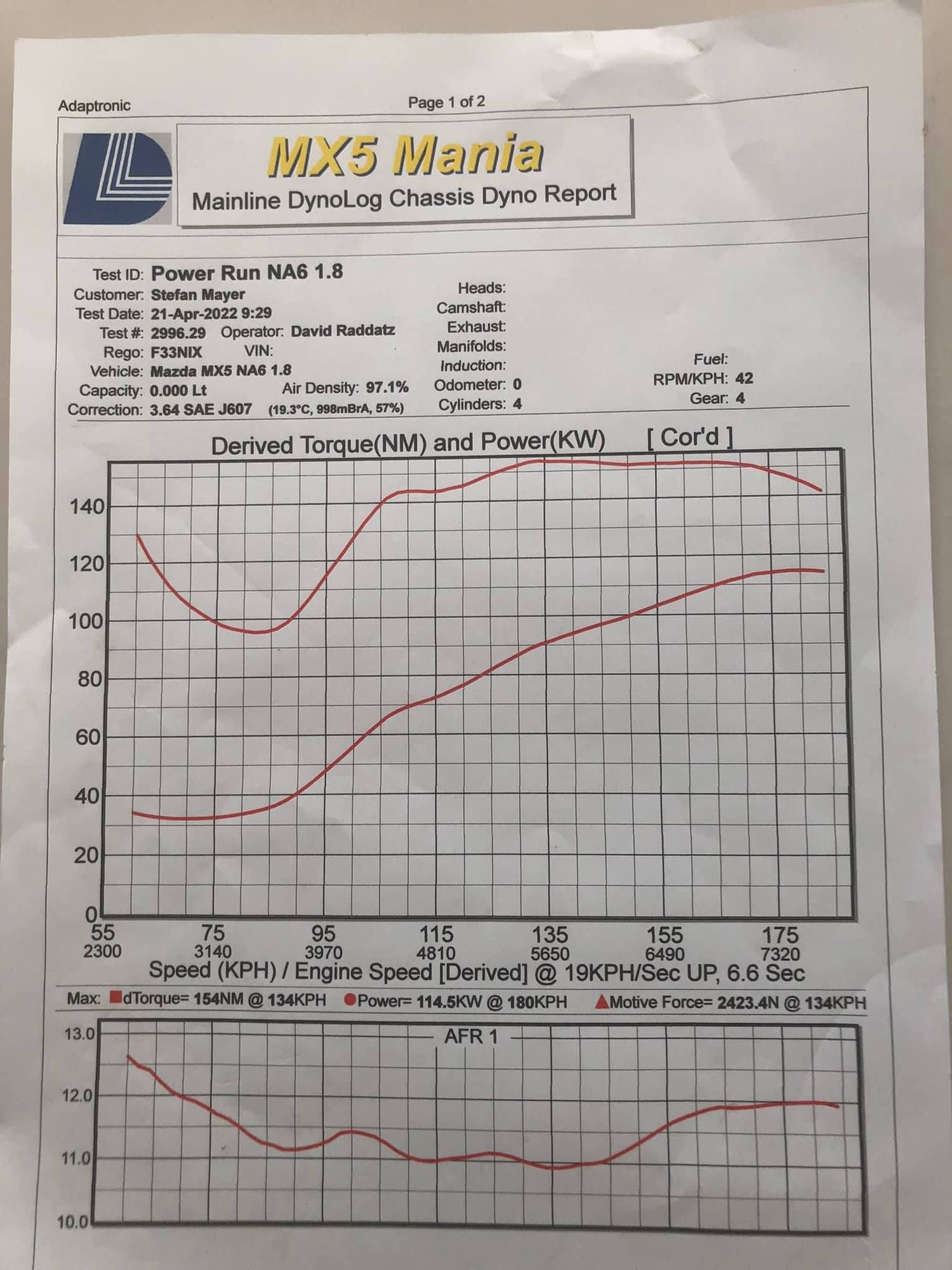
Last edited by StanTheMan; 12-15-2022 at 06:35 PM.
#16
I tend not to drive my car through standing bodies of water...... Anyone from Queensland would have seen the "If it's flooded, forget it" adds 
Power keeps slowly climbing once torque drops off around 5500. Generally only take the car past 7500 to avoid shifting just before a corner. The below graph is from the e85 bottom end I've been running for the last year and a half, compression is about 12:1.
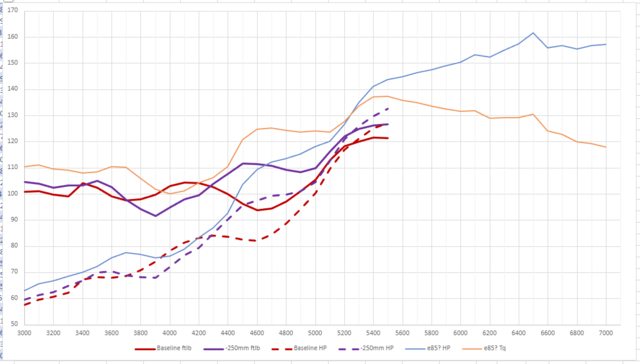
Definitely not vvt... The extra torque is likely from the cam timing... or the intake/exhaust combo. The head's had a lot of work too.

Power keeps slowly climbing once torque drops off around 5500. Generally only take the car past 7500 to avoid shifting just before a corner. The below graph is from the e85 bottom end I've been running for the last year and a half, compression is about 12:1.

Definitely not vvt... The extra torque is likely from the cam timing... or the intake/exhaust combo. The head's had a lot of work too.
Thread
Thread Starter
Forum
Replies
Last Post
TNTUBA
Race Prep
42
09-18-2012 12:42 PM













